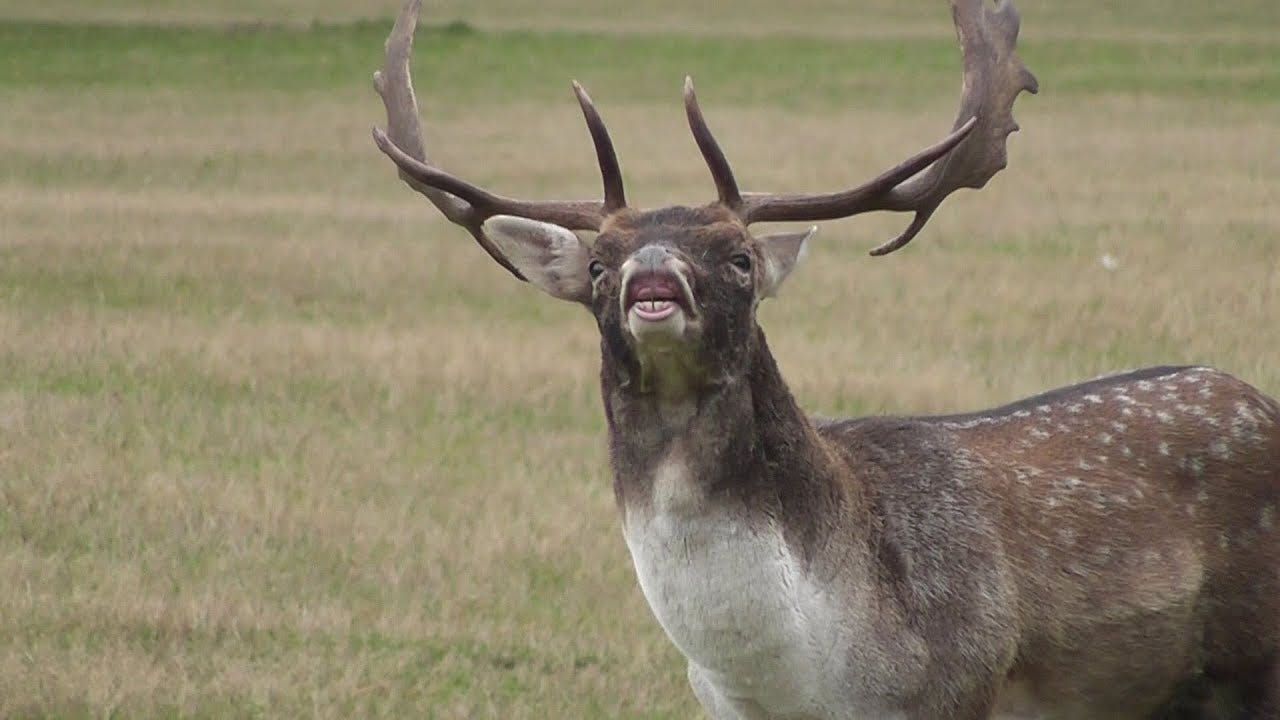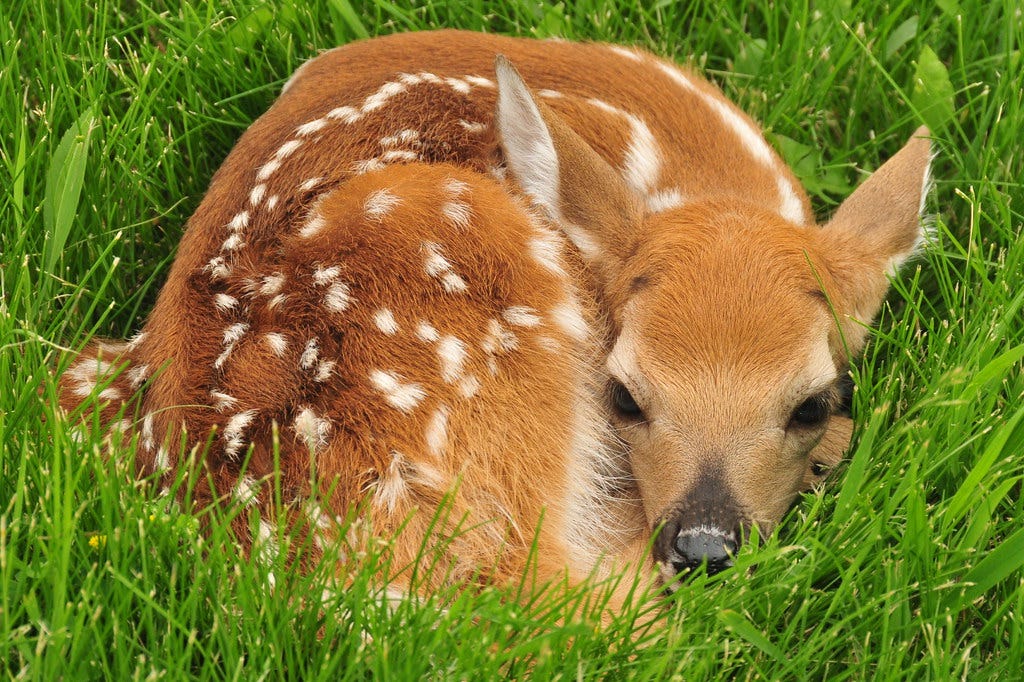The Invisible Ink of Deer Urine
Every squirt and dribble is like a love letter left in the woods.
Welcome back to Sort Of Funny Field Guides, where we’re still thinking about white-tailed deer in honor of hunting season. The email is a bit late this week because I was on the road—a quick trip to New Jersey to meet a super smart little girl and talk to a town about the spotted lanternfly invasion. I hope to tell you all about it in a future post, but for now, let’s talk tarsal glands.
And as always, if you like what you see here, please give it a share!
Do you smellllll what The Buck is cooking?!
Deer are sort of like walking perfume factories—though I doubt you’d want to dab any of their gamey musks behind your ear.
From their literal heads to their literal toes, deer have at least eight different glands that produce scent for chemical communication.
Male deer frequently mark tree trunks and overhanging branches with their forehead glands, which is akin to leaving invisible billboards all over the woods. And when a deer walks along a trail, glands between its hooves leave behind a cocktail of acetic, butyric, isobutyric, propionic, and isovaleric acids. Other deer can pick up on these scents with their snozzes. Interestingly, such compounds are volatile, which means they degrade and change over time. So it’s quite possible that a deer can even determine how long it’s been since another deer dipped its toes in the mud.
What’s really wild is that a deer’s sense of smell is also tangled up with its sense of taste. This is because deer, like most mammals (except humans and other primates), have a special organ in the roof of their mouths. Called the Jacobson’s organ or the vomeronasal organ, this extra little bundle of nerves actually seems particularly good at analyzing urine.
To humans, pee is pee—a foul-smelling, unfortunate byproduct of digestion. We avoid it whenever possible, and we certainly do not put it near our mouths. (Okay, there are exceptions to this rule, but you’ll have to sign up for some other kind of newsletter for that content!)
But to a deer, urine is like a secret message written in invisible ink.
And the vomeronasal organ is the code-breaking machine they use to decipher it.
When a buck catches of a whiff of doe urine on the ground, he might stoop down, curl his lips back, and take a deep, soulful sniff. This suctions microscopic particles of urine into the vomeronasal organ like a vacuum—but it also makes the buck look like a dope.
In fact, this scrunched-up face has its own name, the Flehmen (which means “lip curl” in German), and tons of animals are known to do it, from llamas, rhinos, and giraffes to puppy dogs and house cats. (I wrote a whole story about the Flehmen for Slate Magazine a few years back. It’s free to read, if you want to learn more!)
With their teeth bared and their lips drawn up and out of the way, the Flehmen face is a sign that the animal has decided to engage its olfactory superpower. The vomeronasal organ doesn’t work all the time, and an animal has to turn it on in order to make use of its machinery. Bucks will also flehmen when they encounter chemical signposts left around the woods by other males.
Believe it or not, deer can also change the chemical signatures in their urine by peeing on a gland on the inside of their knees. This patch of skin, known as the tarsal gland, produces a fatty substance that coats a special patch of fur. And scientists have determined that when a deer urinates on this area, those fats attract and stick to fat-soluble compounds in the urine, creating a different combination of smells than would waft away from the gland or the urine by themselves.
It’s kind of like how peanut butter and chocolate are better together than they are alone. KIND OF.
All adult deer seem to perform this so-called rub-urination on a daily basis, but bucks really get after it during the breeding season, which is also known as The Rut. In fact, astute hunters look for dark staining on the hind legs of a buck as a way to determine its maturity level, with the biggest, baddest buck daddies having the darkest and stankest tarsal glands.
For as crucial as scent glands are for most of a deer’s life, there is one short window where they are completely odorless—just after birth.
Within seconds of spilling out of the womb, a mother deer will submit her fawns to a full-body lick-down that removes blood, amniotic fluid, and essentially erases any trace of a scent. Then the mother will take her young one and stash it in a good hiding place.
Deer often have twins, and more rarely, triplets or quadruplets, in which case mom separates each fawn in the litter by several hundred feet. It seems deer adhere to the old adage about not putting all your eggs in one basket.
Spots on the fawn’s back act as visual camouflage amongst the fallen leaves and underbrush, but lack of smell is the true invisibility cloak when it comes to keeping newborns safe from any nifty-nosed predators nearby.
After just a few weeks of intermittent nursing, the fawn is strong enough to accompany its mother, at which point it will begin to smell like a deer. This solidifies the bond between mother and offspring, through a process called imprinting. And this is important, because fawns will sometimes try to suckle from another doe, and by and large, they are rejected—sometimes violently so.
From avoiding predators to finding food, mates, and rivals, there’s a lot going on in the deer world we can’t see or sniff.
Next Week: What Bambi Got Wrong
When SOFFG returns, we’ll discuss how Bambi taught us a neat lesson about deer behavior—a lesson that is totally wrong.
As always, thanks for reading! And if you’re looking for something else to tide you over until next week, hop on over to National Geographic where my colleague, Liz Langley, has a cool story about all the different colors of animal blood. Hint: Red is just the beginning.






